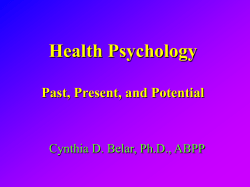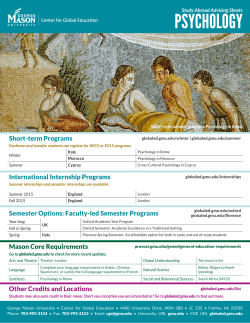
How to Study PSYCHOLOGY Warren Davies
How to Study PSYCHOLOGY Warren Davies How to Study Psychology Do you want to spend less time studying but end up with better grades, and a deeper understanding of the subject? Studying psychology is a skill that can be learned. In this unique and practical ‘how to’ guide, Warren Davies offers some simple techniques that will enable students to keep information in, organise their workload, and be more productive. By applying some simple and easy-to-make changes to your study habits, you’ll learn how to: • • • • • • • • get more work done in less time use memory techniques to help you breeze through exams beat procrastination develop a deep grasp of difficult topics write excellent essays (including how to avoid the seven most common essay errors) write a dissertation to publishable standard understand the ‘results’ section of research papers cut your study time in half. This book is written specifically with psychology undergraduate students in mind, and as such will enhance your learning and improve your grades with techniques that actually work. Warren Davies is a freelance writer with a background in psychology. He finished his Bachelor’s degree in psychology in 2008 and a Masters in applied positive psychology in 2011. He is interested in the factors that affect human performance and well-being and is one of those weird people who actually enjoys statistics. How to Study Psychology Warren Davies Published 2013 by Psychology Press 27 Church Road, Hove, East Sussex BN3 2FA Simultaneously published in the USA and Canada by Psychology Press 711 Third Avenue, New York, NY 10017 Psychology Press is an imprint of the Taylor & Francis Group, an informa business © 2013 Psychology Press The right of Warren Davies to be identified as author of this work has been asserted by him in accordance with sections 77 and 78 of the Copyright, Designs and Patents Act 1988. All rights reserved. No part of this book may be reprinted or reproduced or utilised in any form or by any electronic, mechanical, or other means, now known or hereafter invented, including photocopying and recording, or in any information storage or retrieval system, without permission in writing from the publishers. British Library Cataloguing in Publication Data A catalogue record for this book is available from the British Library Library of Congress Cataloging-in-Publication Data Davies, Warren. How to study psychology / Warren Davies. p. cm. 1. Psychology—Study and teaching. I. Title. BF77.D38 2012 150.71—dc23 2012021443 ISBN: 978-1-84872-106-7 (pbk) ISBN: 978-0-20307-937-9 (ebk) Typeset in Times New Roman by RefineCatch Limited, Bungay, Suffolk Thanks to Vera Hegarty UEL MAPPsters Akem Singh Mum Lyndsey Sue Grandma Contents List of Figures List of Tables ix xi 1 Introduction 1 2 Research methods in psychology 5 3 Statistics and analysis 27 4 Get the information in 51 5 Keep the information in 63 6 Understand the information 73 7 Getting the information out 87 8 Organization and productivity 121 9 Conclusion 137 Appendix A Statistics cheat sheets Appendix B Goal-setting worksheets Appendix C American Psychological Association referencing cheat sheet References Index 139 145 149 153 157 List of Figures 2.1 3.1 3.2 The scientific cycle In a perfect positive correlation, the data points all fall on a straight line In a perfect negative correlation, the data points also fall on a straight line but along the opposite diagonal 3.3 There is no correlation between these two variables 3.4 A weak positive correlation 3.5 A moderate positive correlation 3.6 A strong positive correlation 3.7 A very strong correlation; in fact, the variables may even be the same thing 3.8 The variance that productivity and job satisfaction might share 3.9 The variance that productivity shares with job satisfaction and skill level 3.10 Although motivation does correlate with productivity, it also correlates with job satisfaction and skill level so, in this madeup example, our model already accounts for motivation indirectly 3.11 Graph of the interaction in our music study 7.1 How to write an introduction to a lab report 7.2 How to write the conclusion of a lab report 7 32 33 33 34 35 36 36 39 39 41 47 107 108 List of Tables 3.1 3.2 3.3 3.4 7.1 7.2 7.3 7.4 7.5 The results of our fictional music and happiness study The main effect of music on happiness The main effect of gender on happiness Effect size guidelines The main types of essay question The two structures you can use in evaluation essays Possible structures in a compare and contrast essay Structures you can use in a description essay Some ‘transition words’ you can use to link your paragraphs together 46 46 46 48 91 91 93 95 99 1 Introduction Welcome to this study guide for psychology students. I think I know something about you. Since you have bought this book, I’m fairly safe in assuming you’re a psychology student. If not, you’re almost certainly studying a science of some sort and you perhaps feel a little tinge of anxiety about whether this book is applicable to your subject (don’t worry – it is). As a student, money is a little tight for you and you’re hoping this was a good investment (don’t worry – it was). What else do I know about you? I might deduce that you’re one of the people who actually cares about their course and you want to get something out of it. You bought or otherwise obtained a study guide, after all. You want a good grade; you have a career goal in psychology or maybe you’re just the type of person who likes to do a good job in everything they do. Maybe you’re already doing fairly well on the course but you feel some motivation to do better. This is not the first study guide you’ve read, is it? It’s OK, I’m not the jealous type; you can read around. Or maybe I’ve mistaken you for someone else. You’re on the eve of a deadline or your exams are looming. You bought this book to help you get through this ordeal alive! Left it all to the last minute again, didn’t you? Don’t worry; everyone does that. But, you’ve bought a study guide; that means you care. You have ambition in you. Admit it: you secretly believe you’re capable of doing really well on this course. I bet sometimes, when you’re on the train or the bus, you even allow yourself to daydream about getting top marks. It’s OK, your secret is safe with me. By the way, de-clutter your desk – you’ll feel better. Whoever you are, you feel pressured sometimes. There’s a lot to do on this course, isn’t there? It feels like there’s so much to remember, so much to do and so little time! Sometimes it’s hard to find a balance between studying and having a social life. Sometimes you have to make a choice between the two. Social life usually wins but you wish you could have both. That’s part of your motivation in buying this book – you want to do well academically without sacrificing your personal life – or vice-versa! Have I described you? Maybe I haven’t pinpointed you exactly but you recognize bits of yourself here and there. So as you sit there, hopefully having made the decision to put this book at the top of your ‘to read’ list (which is the right decision, incidentally), let me thank 2 Introduction you for your purchase and express my hope that this book won’t end up on your ‘books to read later’ list. The philosophy behind this book If you break a task down into its constituent parts, then figure out better, quicker or more efficient ways of doing those individual parts, you can improve your performance on the overall task. The organization of this book is based on my subjective breakdown of what is fundamentally involved in studying for a psychology degree and a collection of different ways you can improve within each of these areas. But, we’re all different. Not everything in these pages will appeal to you – or work for you – in your specific situation. If you’re struggling with a particular class or aspect of studying in general, figure out where the problem lies, within the areas I’ll describe, and try to fix it using some of the suggestions. Customize: try things out, notice the results and feel free to modify and adapt the ideas as you go. As Bruce Lee famously said: ‘Absorb what is useful, reject what is useless, and add what is specifically your own.’ How the book is broken down I have broken down the studying process in psychology into seven main sections. These are: • Foundation knowledge: ° ° • Research methods in psychology Statistics Study skills: ° ° ° ° ° Getting information in Keeping information in Understanding information Getting information out Organization and productivity. Most of these are self-explanatory. After getting an understanding of the foundations of the field (trust me: they’re not as scary as you might think), we move on to actual study skills; how to find, not forget, and understand the information you need for your course. Getting information out gives you strategies and tips for your written assignments and exams and the final section explains how you can make better use of your time. How to use this book If you want to read this book cover to cover, you certainly can. But it’s not necessary to read it in that way. You are supposed to read it all but the order is up to you. It’s a reference book, Introduction 3 leave it on your desk, coffee table or even in your bathroom – I don’t mind. Just refer to it regularly and try to read whole sections at a time. To start with, I recommend that you skim through the book and the contents and identify the sections that you think are most pertinent to you. Then read those first. If you’re doing research for an essay, go to page 51. If you’re having trouble understanding something, go to page 73. And so on. If you’re reading this book linearly, we’re going to start by looking at research methods and statistics. I know, I know, you probably hate them. But don’t worry, we’re not going into too much depth and there are no scary equations or anything like that. This stuff is the foundation of your subject and it will be a huge advantage for you to – at the very least – get a broad understanding of why all this stuff needs to be a part of the study of the mind and behaviour. But I hope to give you a bit more than that. 2 Research methods in psychology Richard Feynman once said ‘Social science is an example of a science that is not a science. They follow the forms; you gather data, you do so and so [to it] . . . but they don’t get any laws! They haven’t got anywhere. Yet.’ If I was there at the time Feynman said that, I might have debated the point with him. Since he was a Nobel prize-winning genius, I’d have lost, of course; but that’s not the point. In my view, a field isn’t classed as a science based on whether it has discovered any laws but, rather, on whether they ‘follow the forms.’ In other words, whether they use the scientific method to try to find out about the world. Much to the dismay of many first-year psych students, fresh with enthusiasm from the latest episode of Profiler or Lie to Me, psychology does use the scientific method. So, if you want to understand the field or do well in your course, the first step is to build an understanding of what science is, what it is not, and why. This feels like the donkey work for most people and maybe you’d rather get stuck into theories of behaviour than the philosophy of science. However, the scientific method is the foundation on which all that other stuff is built. If you don’t get a handle on this, you will: • • • • find every journal you read difficult to understand be liable to make mistakes in your work and have a weaker grasp of the subject get lower marks than your classmates who do understand it become more frustrated as time goes on. But if you do get a grasp of this, you will: • • • • be able to understand journal papers more easily be able to criticize studies and theories more easily – which is essential if you want to get a good grade have a better grasp of the field as a whole have the edge over your peers, most of whom do not have this knowledge (you do know you are graded relative to your classmates, don’t you?).
© Copyright 2025





















